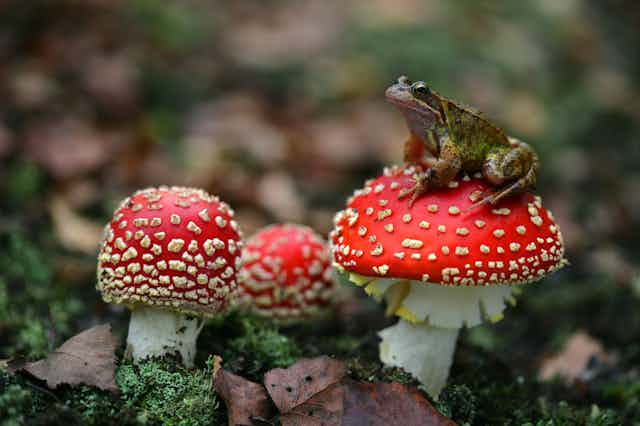Around two in five amphibian species are threatened with extinction around the world. In Britain, all of our native frog, toad and newt species have declined since 1945, with one species – the pool frog – dying out in the 1990s. Climate change, disease and invasive species all have a hand in this, but one of the greatest pressures facing amphibians is the loss of their habitat. As more land is developed for houses, roads and shops, those wild and marshy patches where amphibians thrive are scrubbed from maps.
Setting aside land in nature reserves can help protect biodiversity, though on their own, these islands of natural habitat cannot provide enough space to revive wider communities of wildlife. Since much of the UK’s land is in private hands, conservationists need to think about how nature can be encouraged on land occupied by businesses, including farms, estates and golf courses.
We are two ecologists who are dedicated to restoring habitats for amphibians wherever we can. By working with land managers of all kinds, we’re figuring out how to repopulate modern landscapes with these creatures. Here’s what we’ve learned so far.
Getting landowners onside
Perhaps the most famous amphibians in literature are the unfortunate newts and frogs of Shakespeare’s Macbeth, which end up in the witches’ brew on Forres heath in the Scottish Highlands. Over 400 years later, our own research has shown that populations of great-crested newts face a different kind of toil and trouble.
For centuries, ponds existed on British farmland to water livestock, which offered habitats for amphibians to breed in. But nowadays, sheep and cattle drink from troughs and many wetlands which once sustained wildlife have been drained to create timber plantations and golf courses.

Any plan to halt the decline of Britain’s amphibians must be compatible with different types of land use. So in 2014, we sat down with people working in forestry, farming and a local golf club to develop a plan for restoring 25 ponds in the Scottish Highlands, focusing on Forres and the areas around Inverness which have seen the greatest loss of ponds.
Rather than imposing rules on land managers, we talked with them about their interests and what they saw as important. Pride in their heritage and the opportunity to be seen as good stewards of the land were what most motivated those we spoke to.
One of the sites had been in the owner’s family since the 17th century, and the farmers felt a connection to their land and the wildlife that lived on it. “I may never notice the newts in the pond,” one said. “But I’m glad to know they’re there.”
The golf pro, who had grown up near the course where he now worked, remembered catching newts and tadpoles as a child and wanted his grandchildren to be able to see them too. He used his influence with the club committee to convince them that a pond wouldn’t just be good for nature, but would improve the appearance of the course.
The ground staff joined in to manage vegetation around the ponds to ensure places for the animals to feed outside of the breeding season. Whenever we now survey this pond for species, we’re greeted by golfers who’re proud of “their frogs and newts” and want to know how they’re doing.
Creating the perfect pond
We had permission to start restoring habitats on private land, but how can you tell if what you’re making is right for the species you’re trying to help? Luckily, we had a pretty good idea of what makes the perfect pond because we had 25 years’ worth of data gathered by citizen scientists, as well as our own observations of ponds filled with amphibians.
Everything from the slope of the nearby bank, the presence of fish and insects and the kind of plants which fringed the pool were carefully considered. We then designed ponds ideal for all five amphibian species native to the Scottish Highlands – the common frog, common toad, and smooth, palmate and great-crested newts.

Newts rarely travel more than a few hundred metres, and if the nearest pond is further away or if there’s a barrier like a busy road, they won’t be able to move between ponds. This can lead to inbreeding and leave populations vulnerable to extinction. If a pond dries up for several breeding seasons then it won’t be recolonised once it’s refilled with water. For this reason, we restored former ponds and created new ones close to occupied ponds.
Five years on, 24 out of the 25 ponds are inhabited by amphibians. After surveying our ponds and comparing them with 88 long-established ones in the area, we were delighted to find that not only were all five species breeding in them, including the locally rare great-crested newt, but on average our ponds held more species than the pre-existing ones. We’ve stayed in contact with all the land managers and they remain committed to conservation.
And the one pond with no amphibians? Unfortunately, an error led us to construct a pond that wasn’t quite right. But we accidentally created the perfect pond for a rare dragonfly called the white-faced darter instead. Now we can’t wait to find out what other species might have made our ponds their homes.

